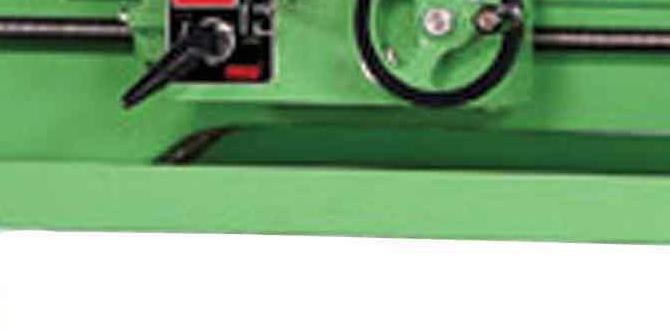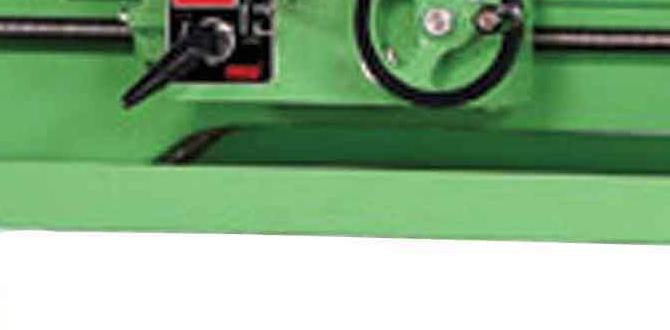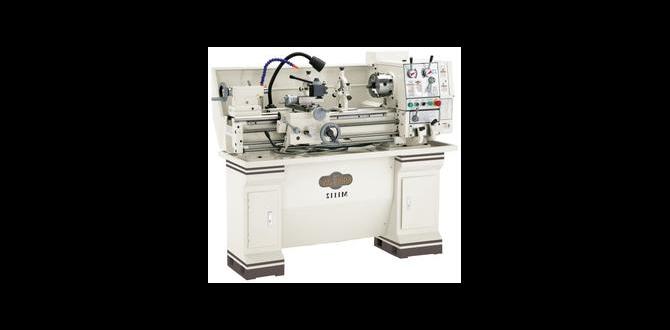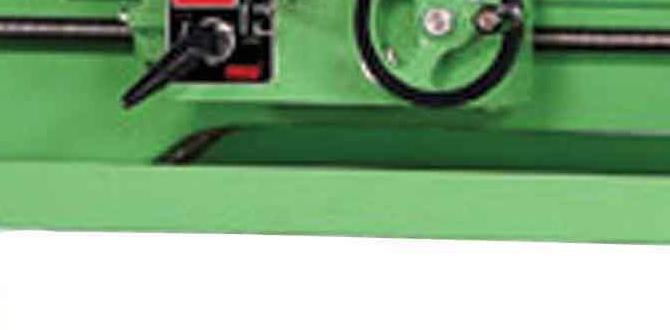Quick Summary
For plywood, an indexable face mill is generally preferred due to its versatility and ability to handle the material’s inconsistencies, offering cleaner cuts and longer tool life than a shell mill. Shell mills can work, but are often better suited for less demanding, bulk material removal.
Indexable Face Mill vs Shell Mill: Plywood’s Essential Choice
Hey there, fellow makers and shop enthusiasts! Daniel Bates here from Lathe Hub. Ever found yourself staring at a piece of plywood, wondering which milling cutter will give you the cleanest, most efficient cut? It’s a common puzzle, especially when you’re just getting started with milling. The difference between an indexable face mill and a shell mill might seem small, but for something as varied as plywood, it can make a world of difference in your project’s finish and your sanity. Don’t worry, we’re going to break it all down super simply, step-by-step. Get ready to choose the right tool and make your plywood cuts shine!
Understanding the Tools: Face Mills and Shell Mills
Before we dive into which one is best for plywood, let’s get a basic understanding of what these two types of milling cutters are. Think of them as specialized tools designed for different jobs on a milling machine, often used for surfacing flat areas or removing large amounts of material.
What is a Face Mill?
A face mill is designed to machine flat surfaces. As the name suggests, its primary function is to “face” off material, meaning it creates a smooth, flat surface. The cutting edges are typically located on the periphery (the outside edge) and sometimes on the face (the flat front) of the cutter head. Many modern face mills are “indexable,” meaning they use small, replaceable cutting inserts made of very hard materials like carbide. These inserts can be rotated or replaced when they become dull or chipped, offering excellent value and consistent cutting performance.
Key Features of Face Mills:
- Insert-based design: Most modern face mills use indexable carbide inserts. These are incredibly hard and can be easily replaced, saving money and time.
- Peripheral and face cutting: They cut with both the sides and the bottom of the inserts to create a flat surface.
- Versatility: They are great for surfacing, creating steps, and general flat area machining.
- Variety of types: You’ll find different styles like “On-Edge” (inserts sit perpendicular to the spindle) and “On-Face” (inserts are parallel to the spindle).
For many applications, especially those requiring a high-quality finish, indexable face mills are the go-to. This is because you can select the right type of insert for the material you’re cutting (like aluminum, steel, or in our case, wood composites).
What is a Shell Mill?
A shell mill, on the other hand, is a type of milling cutter that is designed to be mounted onto an arbor (a shaft) rather than directly into the spindle like many face mills. They are generally wider than they are thick and have a hole in the back for mounting. Like face mills, they also have cutting teeth around their circumference. Shell mills are often used for general-purpose machining, such as cutting slots, pockets, and larger surface areas. They are typically made with solid high-speed steel (HSS) or come with indexable inserts.
Key Features of Shell Mills:
- Arbor mounting: They mount onto a separate arbor, which then fits into the milling machine’s spindle.
- Robust construction: Often designed for aggressive material removal.
- Good for slots and pockets: Their geometry makes them effective for milling these features.
- Can be solid HSS or indexable: While many are solid, indexable versions also exist.
Shell mills are workhorses. Their design allows for strong mounting and they can often handle significant material removal in a single pass. The need for an arbor means an extra step in setup but also allows for a more rigid and stable setup for heavy cuts.
Plywood: The Material Challenge
Now, why is plywood such a particular material when it comes to milling? Plywood isn’t a uniform block of metal or solid wood. It’s made of thin layers, or “plies,” of wood veneer glued together with the grain of each layer running in different directions. This layered structure gives plywood its strength and stability, but it also presents unique challenges for cutting tools.
The Plywood Puzzle:
- Inconsistent Density: The wood species used for different plies can vary, and the glue lines between plies have different properties than the wood itself.
- Abrasive Glues: Many adhesives used in plywood manufacturing can be abrasive, dulling cutting edges faster.
- Grain Direction Changes: As the cutter moves across the surface, it encounters alternating grain directions (cross-grain and long-grain). This can lead to tear-out and chipping, especially on the edges.
- Variability: Not all plywood is created equal. Construction-grade plywood might have voids or knots, while high-quality hardwood ply will be denser and more uniform.
These factors mean that a cutting tool needs to be able to handle these inconsistencies gracefully. We want a tool that can “slice” through the different layers without ripping them apart, and one that can withstand the potentially abrasive environment for a reasonable amount of time.
Indexable Face Mill vs. Shell Mill for Plywood: The Showdown
When we put our understanding of these tools up against the challenges of milling plywood, a clearer picture emerges. For general woodworking and precise shaping of plywood on a milling machine, the indexable face mill often has an edge.
Why Indexable Face Mills Shine for Plywood:
- Controlled Cutting Action: The inserts on a face mill are designed for a clean shearing action. This is crucial for plywood, allowing the tool to smoothly cut through the different wood fibers and glue lines without snagging or tearing.
- Customizable Inserts: You can select specific carbide or PCD (polycrystalline diamond) inserts designed for wood or plastics. These materials are much harder and sharper than standard HSS, leading to cleaner cuts and significantly longer tool life, especially important with abrasive glues. For plywood, sharp, high-quality inserts are a game-changer.
- Surface Finish: Face mills, by design, are excellent at creating flat, smooth surfaces. This is often a primary goal when milling plywood, whether it’s for creating a perfectly flat panel or machining precise joinery.
- Reduced Tear-Out: The way a face mill approaches the material, often with a slight lead angle on the inserts, helps to minimize chipping and tear-out on the edges of the plies as the cutter moves across the surface.
- Multi-Fluted Designs: Many indexable face mills have multiple inserts (flutes). This allows material to be removed more efficiently and can contribute to a smoother finish as the load is distributed.
When a Shell Mill Might Be Considered (and its Limitations):
A shell mill can be used for plywood, but it’s often not the ideal first choice for precision or fine finishing. Here’s why:
- Aggressive Material Removal: Shell mills are geared more towards bulk material removal. While this can be useful for hogging out large pockets, it might be too aggressive for achieving a smooth finish on plywood, potentially leading to more tear-out.
- Solid HSS Limitations: If you’re using a solid HSS shell mill, the edge will dull considerably faster when encountering glues and the hard layers within plywood. This means more frequent sharpening and a decline in cut quality over time.
- Mouting and Setup: While robust, the arbor mounting can sometimes introduce slight runout (wobble) if not set up perfectly, which can impact surface finish.
- Less Ideal for Surfacing: While they can face a surface, their design is often more optimized for slotting and peripheral cutting compared to the specialized surfacing action of a face mill.
Think of it this way: if you need to quickly level a large area or mill a wide slot with less concern for a perfect edge finish, a shell mill might suffice. However, for the kind of detail and precision often required in woodworking projects with plywood, an indexable face mill offers superior control, finish, and longevity.
Choosing the Right Inserts for Plywood
The real magic of an indexable face mill lies in the inserts. For plywood, you’ll want to focus on inserts that are:
- Specifically designed for wood or non-ferrous materials: These are often made from tungsten carbide with specific grades formulated for wood.
- Sharp and with a positive rake angle: A sharp tool cuts cleanly. A positive rake angle helps the tool to “slice” rather than “push” through the material, which reduces tear-out.
- Coated carbide: Coatings can add hardness and reduce friction, extending insert life and improving chip evacuation.
- Consider PCD (Polycrystalline Diamond): For high-volume or very demanding applications where budget allows, PCD inserts offer unparalleled hardness and edge retention for wood composites, but they come at a premium price.
Consulting with tool manufacturers or your supplier is a great idea. They can recommend specific insert geometries and grades that are optimized for materials like plywood. Resources like CarbideProcess.com offer insights into carbide properties which can be helpful in understanding why certain grades are better for specific materials.
Practical Setup and Operation Tips
Once you’ve chosen your indexable face mill and the right inserts, setting up and using it correctly is key. This applies whether you’re using a manual milling machine or a CNC.
Step-by-Step Milling Plywood with an Indexable Face Mill:
- Secure the Workpiece: Ensure your plywood is firmly clamped to the milling machine table. Use sturdy clamps and avoid letting the workpiece lift or shift during the cut. Double-sided tape can also be used for smaller pieces, but clamps are generally safer for milling operations.
- Mount the Face Mill: Mount your indexable face mill securely onto the milling machine’s spindle or arbor. Ensure it’s clean and properly seated to minimize runout.
- Set the depth of cut: Carefully adjust the Z-axis (height) of your milling machine to set the desired depth of cut for your face mill. For plywood, start with a relatively shallow depth of cut, especially on the first pass. A good starting point might be 1-3mm (0.04-0.12 inches), depending on the power of your machine and the inserts used.
- Set the Feed Rate: Choose an appropriate feed rate. For wood, a slower to moderate feed rate is generally better to achieve a clean finish and avoid burning. The feed rate is how fast the table moves the workpiece into the cutter.
- Begin the Cut: Start the spindle and slowly lower the face mill into the plywood. Move the cutting head (or the table) across the surface of the material in a controlled manner, ensuring full engagement of the cutter.
- Observe and Listen: Pay attention to the sound of the cut and the chips being produced. A clean cut will sound smooth. If you hear chattering or see excessive burning, you may need to adjust your speed, feed, or depth of cut.
- Make Subsequent Passes: If a deeper cut is required, make full passes at your initial depth until the desired surface is reached. Avoid trying to take too much material off in a single pass, as this can overload the tool and the machine, and lead to a poor finish.
- Clean Up: Once milling is complete, use a brush or compressed air to clean away the sawdust and chips from the workpiece and machine.
Important Considerations:
- Dust Collection: Milling plywood creates a lot of fine dust. Ensure you have adequate dust collection in place to maintain a clean working environment and for health reasons. Check out resources from organizations like the Occupational Safety and Health Administration (OSHA) for guidance on managing woodworking dust.
- Spindle Speed (RPM): The optimal spindle speed depends on the diameter of the face mill and the type of inserts used. Generally, for wood composites with carbide inserts, speeds might range from 5,000 to 20,000 RPM, but always check manufacturer recommendations.
- Coolant (Optional for Wood): While coolant is standard in metal milling, it’s rarely used for milling plywood. Air blast can help keep the cutting area clear of debris and reduce heat build-up.
Indexable Face Mill vs. Shell Mill for Plywood: Pros and Cons
To help solidify your decision, let’s lay out the advantages and disadvantages of each tool specifically when it comes to milling plywood.
Indexable Face Mill
| Pros | Cons |
|---|---|
| Excellent surface finish, minimal tear-out. | Can be more expensive upfront than a basic shell mill. |
| Versatile with interchangeable inserts for different materials. | Requires careful selection of the right inserts for optimal performance on plywood. |
| Sharp, replaceable inserts mean consistent performance and longer tool life. | Setup might feel slightly more complex to absolute beginners compared to a simple solid tool. |
| Good for surfacing, creating flat areas, squaring edges. | Might not be as robust for very aggressive “hogging out” as some heavy-duty shell mills. |
| Generally easier to achieve a high-quality, clean cut. |
Shell Mill
| Pros | Cons |
|---|---|
| Often more affordable for basic solid HSS versions. | Prone to more tear-out and chipping on plywood edges. |
| Good for bulk material removal, milling slots and pockets. | Solid HSS inserts dull much faster on plywood, reducing cut quality. |
| Robust and sturdy for aggressive machining. | Surface finish is typically not as smooth or precise as a face mill. |
| Simple to mount on an arbor for rigidity. | Requires an arbor, adding an extra component to purchase and manage. |
| Can be a good “workhorse” tool for roughing. | Less adaptable for fine finishing or materials with varying densities like plywood. |
As you can see, for the delicate and inconsistent nature of plywood, the indexable face mill offers a more controlled and refined approach. Its ability to use specialized inserts and achieve a clean shear cut makes it the superior choice for most plywood milling applications in a home workshop or for hobbyists.
When to Consider Other Options (Briefly)
While indexable face mills and shell mills are common, it’s worth mentioning that other cutters exist, and sometimes a different tool is better suited for specific plywood tasks.
- Router Bits in a Mill: For some lighter plywood tasks, especially if you’re primarily using a CNC where rigidity is less of an issue, specialized router bits designed for CNC work can be used in your milling machine. They are often designed for wood and can yield excellent results, but might not withstand the forces of a heavy manual milling operation as well as a dedicated milling cutter.
- Solid carbide end mills: For smaller details, pockets, or dados, a solid carbide end mill designed for wood can be excellent. These are not “face mills” or “shell mills” but are versatile tools for a milling machine.
However, for facing off surfaces or general flattening of plywood panels, the indexable face mill remains the top choice for balancing quality, efficiency, and tool life.
Frequently Asked Questions (FAQ)
Q1: Can I use a regular wood router bit in my milling machine for plywood?
A1: Yes, you can often use router bits in a milling machine, especially with a router collet adapter. However, be mindful that router bits are often designed for higher RPMs and less robust cutting forces than milling cutters. For plywood, ensure the bit is sharp and designed for clean cutting. Dedicated milling cutters, especially indexable face mills, generally offer better control and finish in a milling environment.
Q2: What’s the biggest issue when milling plywood?
A2: The biggest issue is usually tear-out and inconsistent cuts. Plywood has alternating grain directions, glue lines, and varying wood densities, which can cause the cutter to snag, chip, or burn the material, leading to a rough finish and damaging the tool faster.
Q3: How deep should I cut in plywood with a face mill?
A3: It’s best to start with shallow cuts, perhaps 1




